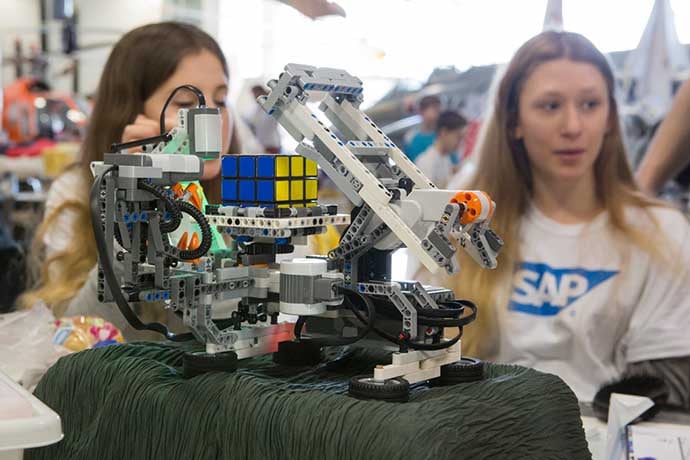What Does Robot Mean?
Most of us know what a robot is, but many people do not know what the word means. It comes from the Czech word “robota”, meaning forced labor! Therefore, a robot is a machine that we can build that will do labor, or work, for us.
Building a robot single-handedly, completely from scratch, requires learning mechanics, electronics, and programming.
Luckily, Lego has given us a great place to start by creating a robotics kit called EV3. With a Lego EV3 set, we can build robots of all sorts that can do all kinds of work: lifting, throwing, flapping, rolling, and much more.
What’s in the Box?
It depends on which edition you buy. In the Home Edition, you’ll find approximately 600 building elements. Many of these are Lego pieces that you can find in a Lego technic set. They include axles, gears, beams, and connectors to name a few.
Additionally, there is an EV3 Brick (the programmable “brains” of the set), two large motors, one medium motor, one touch sensor, one color sensor, one infrared sensor and an infrared remote. Lego also offers another edition called the Education Set.
The Education Set has fewer building elements, but there is an additional touch sensor and ultrasonic sensor, as well as a gyro sensor. The Education Edition does not include an infrared sensor or remote. It is a good choice for those who are interested in doing science experiments and logging data, as the sensors and software are designed for such projects.
Get Things Moving
A good way to set a robot in motion is to give it a motor, and then program the motor to rotate. So, before building a robot, let’s start by getting the motor turning. To do this, you’ll need EV3’s programming environment, LabView, which can be downloaded for free.
Once LabView is installed, connect the brick block to the computer via the included USB cable, and a large motor piece to the brick via one connector cable. Open the LabView programming software and find the large motor block in the green palette.

Connect it to the play block. The large motor block gives several programming options. We can program it for a given number of seconds, a given number of rotations, or a given number of degrees. We can also choose the rotation speed.

Next, download the program to the brick, and the program will appear on the brick’s screen. Select it to see the motor rotate.
Next Steps
Once we have a rotating motor, all types of possibilities arise. Attach wheels to make vehicles, rods to make swinging pendulums, and other Lego elements to design robots of endless variety.
With a bit of guidance from The Lego Mindstorms EV3 Idea Book, using 19 additional Lego pieces, we converted the motion of the rotating motor into that of flapping wings. Adding a second large motor lets our bird flap and roll at the same time.
Extendibility
One fun way to stand out among EV3 users is to turn an Android phone or tablet into a remote control using MIT App Inventor. For those looking to explore electronics a bit deeper, EV3 and Arduino can be used together, allowing access to all Arduino-compatible sensors. And for folks that program using Scratch and prefer not to learn a second drag-and-drop programming language, Scratchx.org has an EV3 extension.

